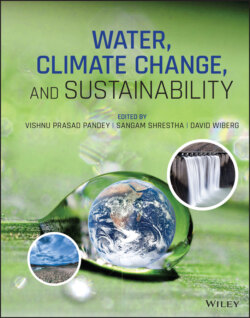Читать книгу Water, Climate Change, and Sustainability - Группа авторов - Страница 53
3.5.4. Tools Used to Evaluate the Sustainability of Bio‐Based Systems
ОглавлениеA variety of tools are available to evaluate industrial processes, but very few have been exclusively designed for bio‐based systems. The most complete tools to analyze bio‐based systems use a life cycle approach that evaluate the whole bio‐based system from agricultural production to final product use and disposal (cradle‐to‐grave). Many methodologies can be used for LCA, but most are based on the standard ISO 14040/44 (International Organization for Standardization, 2006). LCA results can include water and energy use, in addition to impact categories indirectly related to water and energy, such as GWP, eutrophication, and acidification. S2BIOM is an LCA‐based tool designed specifically for the environmental sustainability assessment of non‐food biomass supply chains (Manfredi, 2014).
Eco‐efficiency analysis (EEA) is a LCA‐based comparative methodology developed by BASF SE that includes life cycle environmental and cost analyses, and assists in decision‐making along the value chain (Saling et al., 2002). EEA impact categories include materials use, energy use, emissions, toxicity potential, risk potential, and land use (Sheldon, 2018). EEA was expanded into the SocioEcoEfficiency Analysis (SEEbalance), adding a social LCA and a social hotspot assessment that link the social impact of the process to the SDGs (Schmidt et al., 2004). In addition, BASF SE has also developed AgBalance, a tool designed to evaluate the sustainability of agricultural systems. AgBalance combines SEEbalance with a set of agriculture‐specific indicators such as biodiversity, land use, and soil health (Saling et al., 2014).
LCAs, however, require a significant amount of data that might not be available for new processes and can be time consuming. Thus, some tools have been designed to simplify the sustainability assessment. The Gauging Reaction Effectiveness for the Environmental Sustainability of Chemistries with a Multi‐Objective Process Evaluator (GREENSCOPE) is a tool developed by the US Environmental Protection Agency to assess the sustainability of chemical processes, that has been applied to biomass conversion processes into biofuels and bioproducts (Ruiz‐Mercado et al., 2013). GREENSCOPE is a gate‐to‐gate methodology, but it can be integrated with life‐cycle inventory (LCI) to assist the design of global sustainable processes (Ruiz‐Mercado et al., 2014).
Other tools designed to simplify the environmental assessment have been developed in the chemical industry. Fast Life Cycle Assessment of Synthetic Chemistry (FLASC) from Glaxo Smith Kline plc, Eco‐footprint from Chimex SA, and GREEN MOTION from Mane SA have been used for the assessment of bioprocess. FLASC includes several energy and water related indicators, such as energy use, GHG emissions, oil and natural gas depletion, acidification and eutrophication potential. Eco‐footprint includes water and carbon footprint, aqueous waste valorization, and energy use (Leseurre et al., 2014). Green motion accounts for energy and water used as solvent, but not wastewater (Phan et al., 2015).
Water Accounting and Vulnerability Evaluation (WAVE) is a method that assesses the blue water used in processes by evaporation and product integration and the vulnerability of drainage basins to water depletion. WAVE includes local water scarcity but does not measure water quality degradation. This methodology has been used to assess the water footprint of bioethanol production from sugarcane in different countries (Berger et al., 2014).
Some methods have been designed specifically for bio‐based systems. Sheldon and Sanders (2015) developed a set of indicators to evaluate the production of commodity chemicals from biomass and compared them with their fossil fuel analogues. This methodology focuses on energy efficiency, materials, land use, and process economics. Patel et al. (2012) proposed a methodology for the fast‐preliminary assessment of biofuels and biochemicals from biomass, that uses the CED, but does not include water use. Nguyen et al. (2015) presented a method for the design and assessment of bio‐based processes that includes environmental, economic, and social criteria, and uses indicators such as fossil energy use, GHG emissions, eutrophication, and acidification. The GREET model is a database tool that calculates life cycle energy use and emissions from vehicles and fuels, and includes the pathways for several biofuels production, such as corn and cellulosic ethanol, and soybean biodiesel (Burnham et al., 2006).
Tools for the sustainability assessment of farms include the Farm Energy Analysis Tool (FEAT), a database model that accounts for energy used and GHG emissions and allows for the sustainability assessment of different crops and management practices (Camargo et al., 2013). Gaviglio et al. (2017) proposed a tool that combines descriptive analysis and data aggregation and uses indicators such as water resource management, energy dependence, and renewable energy use.
